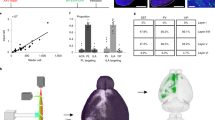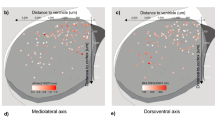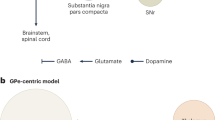Abstract
Although cell-stained sections have suggested heterogeneity in the neostriatum1, more conclusive evidence has come from selective neurochemical staining for receptors, enzymes or neural connections. For example, opiate receptors in the rat striatum are concentrated in discrete islands and in a streak under the corpus callosum2,3—regions that lack any visible morphological distinction. In the monkey, cortical afferent fibres terminate in intricate patterns4. In the cat striatum, variations in the intensity of acetycholinesterase (AChE) staining5 coincide with complex mosaic patterns of striatal efferent neurones, with cortical afferent terminations6 and with enkephalin-like immunoreactivity7. In both cats8 and monkeys9, thalamic afferent fibres, from the parafascicular–centre median complex, terminate in discrete clusters. Even the intensely studied nigrostriatal dopamine pathway, previously assumed to project diffusely throughout the caudate, can be shown to be heterogeneous by pharmacological methods10. To extend this evidence, we decided to examine, on serial sections of the same rat striatum, four different histological markers of striatal heterogeneity. We now report that there is a precise mosaic ‘fit’ in striatal ‘islands’ of closely packed opiate receptors, vacancies in the termination of parafascicular projections and AChE-poor zones.
This is a preview of subscription content, access via your institution
Access options
Subscribe to this journal
Receive 51 print issues and online access
$199.00 per year
only $3.90 per issue
Buy this article
- Purchase on Springer Link
- Instant access to full article PDF
Prices may be subject to local taxes which are calculated during checkout
Similar content being viewed by others
References
Mensah, P. L. Brain Res. 137, 53–66 (1977).
Pert, C. B., Kuhar, M. J. & Snyder, S. H. Life Sci. 16, 1849–1854 (1975).
Pert, C. B., Kuhar, M. J. & Snyder, S. H. Proc. natn. Acad. Sci. U.S.A. 73, 3729–3733 (1976).
Goldman, P. S. & Nauta, W. J. H. J. comp. Neurol. 171, 369–386 (1977).
Graybiel, A. M., Ragsdale, C. W. & Moon Edley, S. Expl Brain Res. 34, 189–195 (1979).
Ragsdale, C. W. & Graybiel, A. M. Soc. Neurosci. Abstr. 5, 78 (1979).
Greybiel, A. M., Ragsdale, C. W., Yoneoka, E. S. & Elde, R. P. Soc. Neurosci. Abstr. 6, 342 (1980).
Royce, G. J. Brain Res. 146, 145–150 (1978).
Kalil, K. Brain Res. 140, 333–339 (1978).
Olson, L., Seiger, A. & Fuxe, K. Brain Res. 44, 283–288 (1972).
Herkenham, M. & Pert, C. B. Proc. natn. Acad. Sci. U.S.A. 77, 5532–5536 (1980).
Herkenham, M. J. comp. Neurol. 183, 487–518 (1979).
Hardy, H., Heimer, L., Switzer, R. & Watkins, D. Neurosci. Lett. 3, 1–5 (1976).
Pert, C. B., Taylor, D. P., Pert, A., Herkenham, M. A. & Kent, J. L. in Neural Peptides and Neuronal Communication (eds Costa, E. & Trabucchi, M.) 581–589 (Raven, New York, 1980).
Bowen, W. D., Gentleman, S., Herkenham, M. & Pert, C. B. Proc. natn. Acad. Sct. U.S.A. (in the press).
Graybiel, A. M. & Ragsdale, C. W. Proc. natn. Acad. Sci. U.S.A. 75, 5723–5726 (1978).
Goodman, R. R., Snyder, S. H., Kuhar, M. J. & Young, W. S. III Proc. natn. Acad. Sci. U.S.A. 77, 6239–6234 (1980).
Lord, J. A. H., Waterfield, A. A., Hughes, J. & Kosterlitz, H. W. Nature 267, 495–499 (1977).
Potter, A., Field, P. M. & Raisman, G. Brain Res. Rev. 1, 185–205 (1979).
Kent, J. L., Pert, C. B. & Herkenham, M. Devl Brain REF. (in the press).
Birdsall, N. J. M., Hulme, E. C. & Burgen, A. Proc. R. Soc. A207, 1–12 (1980).
Keefer, D. A. Cell Tissue Res. 209, 167–175 (1980).
de la Torre, J. C. & Surgeon, J. W. Histochemistry 49, 81–93 (1976).
Pert, A. in Characteristics and Function of Opioids Developments in Neuroscience Vol. 4 (eds Van Ree, J. M. & Terenius, L.) 389–401 (Elsevier, Amsterdam, 1978).
Iwatsubo, K. & Clouet, D. H. Biochem. Pharmac. 24, 1499–1503 (1975).
Hong, J. S., Yang, H.-Y. T., Fratta, W. & Costa, E. J. Pharmac. exp. Ther. 205, 141–147 (1978).
Parenti, M., Gentleman, S. & Neff, N. H. Fedn Proc. 39, 516 (1980).
Hökfelt, T. et al. in Neural Peptides and Neuronal Communication (eds Costa, E. & Trabucchi, M.) 1–23 (Raven, New York, 1980).
Author information
Authors and Affiliations
Rights and permissions
About this article
Cite this article
Herkenham, M., Pert, C. Mosaic distribution of opiate receptors, parafascicular projections and acetylcholinesterase in rat striatum. Nature 291, 415–418 (1981). https://doi.org/10.1038/291415a0
Received:
Accepted:
Issue Date:
DOI: https://doi.org/10.1038/291415a0
This article is cited by
-
Persistent enhancement of basolateral amygdala-dorsomedial striatum synapses causes compulsive-like behaviors in mice
Nature Communications (2024)
-
Generalized and social anxiety disorder interactomes show distinctive overlaps with striosome and matrix interactomes
Scientific Reports (2021)
-
Mesolimbic opioid-dopamine interaction is disrupted in obesity but recovered by weight loss following bariatric surgery
Translational Psychiatry (2021)
-
Morphological Study of the Cortical and Thalamic Glutamatergic Synaptic Inputs of Striatal Parvalbumin Interneurons in Rats
Neurochemical Research (2021)
-
The non-receptor tyrosine kinase Pyk2 modulates acute locomotor effects of cocaine in D1 receptor-expressing neurons of the nucleus accumbens
Scientific Reports (2020)
Comments
By submitting a comment you agree to abide by our Terms and Community Guidelines. If you find something abusive or that does not comply with our terms or guidelines please flag it as inappropriate.



